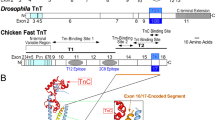Summary
We have cloned and determined the nucleotide sequence of a complementary DNA (cDNA) encoded by a newly isolated human tropomyosin gene and expressed in liver. Using the leastsquare method of Fitch and Margoliash, we investigated the nucleotide divergences of this sequence and those published in the literature, which allowed us to clarify the classification and evolution of the tropomyosin genes expressed in vertebrates. Tropomyosin undergoes alternative splicing on three of its nine exons. Analysis of the exons not involved in differential splicing showed that the four human tropomyosin genes resulted from a duplication that probably occurred early, at the time of the amphibian radiation. The study of the sequences obtained from rat and chicken allowed a classification of these genes as one of the types identified for humans.
The divergence of exons 6 and 9 indicates that functional pressure was exerted on these sequences, probably by an interaction with proteins in skeletal muscle and perhaps also in smooth muscle; such a constraint was not detected in the sequences obtained from nonmuscle cells. These results have led us to postulate the existence of a protein in smooth muscle that may be the counterpart of skeletal muscle troponin.
We show that different kinds of functional pressure were exerted on a single gene, resulting in different evolutionary rates and different convergences in some regions of the same molecule.
Codon usage analysis indicates that there is no strict relationship between tissue types (and hence the tRNA precursor pool) and codon usage. G+C content is characteristic of a gene and does not change significantly during evolution. These results are in good agreement with an isochore composition of the genome, and thus suggest a similar chromosomal environment in chicken, rat, and human.
Similar content being viewed by others
References
Alonso S, Minty A, Bourlet Y, Buckingham M (1986) Comparison of three actin-sequences in the mouse; evolutionary relationships between the actin genes of warm-blooded vertebrates. J Mol Evol 23:11–22
Bernardi G, Bernardi G (1985) Codon usage and genome composition. J Mol Biol 22:363–365
Bernardi G, Bernardi G (1986) Compositional constraints and genome evolution. J Mol Evol 24:1–11
Bernardi G, Olofsson B, Filipski J, Salinas J, Cuny G, Meunier-Rotival M, Rodier F (1985) The mosaic genome of warmblooded vertebrates. Science 228:953–958
Berstein B, Bambourg J (1982) Tropomyosin binding to F-actin protects the F-actin from disassembly by actin depolymerising factor. Cell Motil 2:1–8
Cavadore JC, Berta P, Axelrud-Cavadore C, Haiech J (1985) Calcium binding of arterial tropomyosin: involvement in the thin filament regulation of smooth muscle. Biochemistry 24:5216–5221
Cooper H, Feurstein N, Noda M, Bassin R (1985) Suppression of tropomyosin synthesis, a common biochemical feature of oncogenesis by structurally diverse retroviral oncogenes. Mol Cell Biol 5:972–983
Cote G, Lewis W, Pato M, Smillie L (1978) Platelet tropomyosin: lack of binding to skeletal muscle troponin and correlation with sequence. FEBS Lett 94:131–135
Fitch WM, Margoliash E (1967) Construction of phylogenetic trees. Science 155:279–284
Flach J, Lidquester G, Berish S, Hickam K, Devlin R (1986) Analysis of tropomyosin cDNAs isolated from skeletal and smooth muscle mRNA. Nucleic Acids Res 14:9193–9211
Giometti C, Anderson L (1984) Tropomyosin heterogeneity in human cells. J Biol Chem 259:14113–14120
Helfman D, Cheley S, Kuismanen E, Finn L, Yamawaki-Kataoka Y (1986) Non muscle and muscle tropomyosin isoforms are expressed from a single gene by alternative RNA splicing and polyadenylation. Mol Cell Biol 6:3582–3595
Helfman D, Faramisco J, Ricci W, Hughes S (1984) Isolation and sequence of a cDNA clone that contains the entire coding region for chicken smooth muscle tropomyosin. J Biol Chem 259:14136–14143
Hendricks M, Weintraub H (1981) Tropomyosin is decreased in transformed cells. Proc Natl Acad Sci USA 78:5633–5637
Leavitt J, Latter G, Lutomski L, Goldstein D, Burbeck S (1986) Tropomyosin isoform switching in tumorigenic human fibroblast. Mol Cell Biol 6:2721–2726
MacLeod A (1982) Distinct α-tropomyosin mRNA sequences in chicken skeletal muscle. Eur J Biochem 126:293–297
MacLeod A, Houlker C, Reinach F, Smillie L, Talbot K, Modi G, Walsh F (1985) A muscle-type tropomyosin in human fibroblasts: evidence for expression by an alternative RNA splicing mechanism. Proc Natl Acad Sci USA 82:7835–7839
MacLeod A, Houlker C, Reinach F, Talbot K (1986) The mRNA and RNA-copy pseudogenes encoding TM30 nm a human cytoskeletal tropomyosin. Nucleic Acids Res 14:8413–8426
MacLeod A, Talbot K, Smillie L, Houlker C (1987) Characterisation of a cDNA defining a gene family encoding TM30 pl a human fibroblast tropomyosin. J Mol Biol 194:1–10
Maxam AM, Gilbert W (1980) Sequencing of end-labelled DNA with base specific cleavage reactions. Methods Enzymol 65:499–560
McLachlan A, Stewart M (1975) Tropomyosin coiled-coil interactions: evidence for an unstaggered structure. J Mol Biol 98:293–304
Paulin D, Perreau J, Jakob H, Jacob F, Yaniv M (1979) Tropomyosin synthesis accompanies formation of actin filaments in embryonal carcinoma cells induced to differentiate by hexamethylene bisacetamide. Proc Natl Acad Sci USA 76:1891–1895
Reinach F, MacLeod A (1986) Tissue-specific expression of the human tropomyosin gene involved in the generation of the trk oncogene. Nature 322:648–650
Ruiz-Opazo N, Weinberger J, Nadal-Ginard B (1985) Comparison of α-tropomyosin sequences from smooth and striated muscle. Nature 315:67–70
Sanger F, Niclen S, Coulson A (1977) DNA sequencing with chain terminating inhibitors. Proc Natl Acad Sci USA 74:5463–5467
Smillie L (1979) Structure and function of tropomyosins from muscle and non-muscle sources. Trends Biochem Sci 4:151–155
Staden R (1982) An interactive graphics program for comparing and aligning nucleic acid and amino acid sequences. Nucleic Acids Res 10:2951–2960
Stossel T, Chaponnier C, Ezzell R, Hartwig J, Janmey P, Kwiatkosky D, Lind S, Smith D, Southwick, Yin H, Zaner K (1985) Nonmuscle actin-binding proteins. Annu Rev Cell Biol 1:353–402
Author information
Authors and Affiliations
Rights and permissions
About this article
Cite this article
Colote, S., Widada, J.S., Ferraz, C. et al. Evolution of tropomyosin functional domains: Differential splicing and genomic constraints. J Mol Evol 27, 228–235 (1988). https://doi.org/10.1007/BF02100079
Received:
Revised:
Accepted:
Issue Date:
DOI: https://doi.org/10.1007/BF02100079




